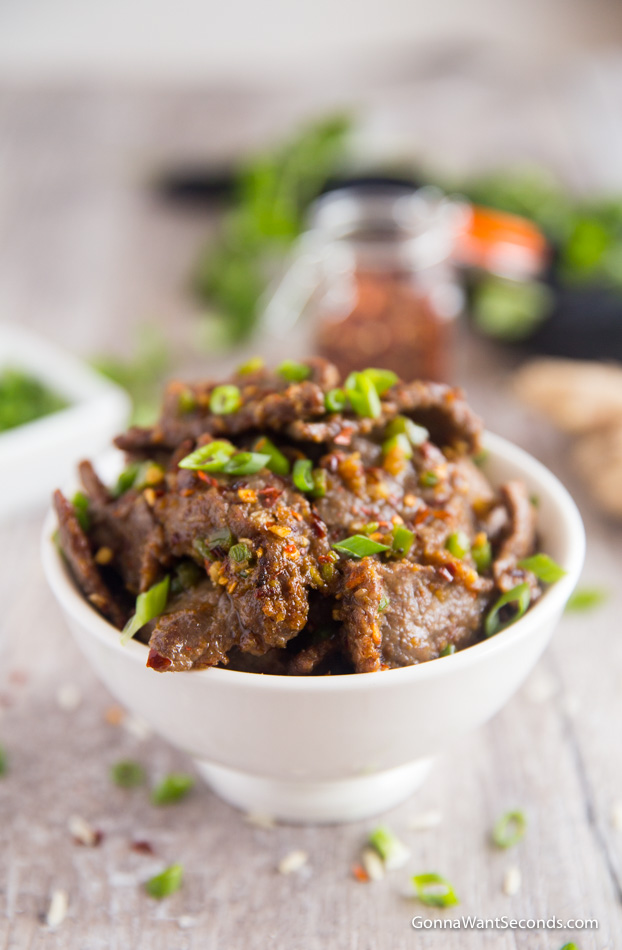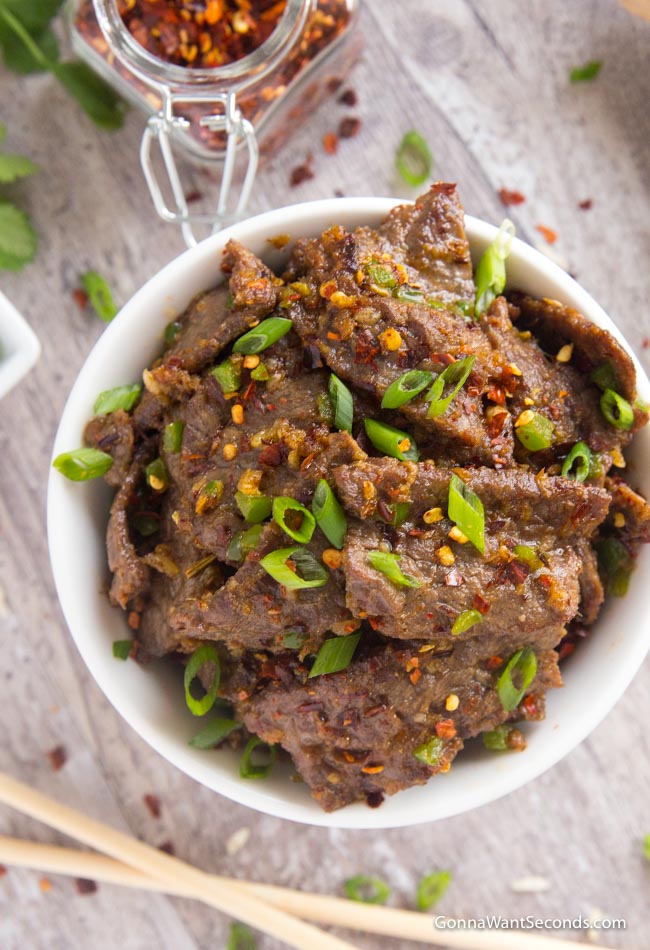My Hunan Beef Recipe beats any take-out and will be ready before you can say “fortune cookie.” Your kitchen never smelled so good!

Did you know there are more Chinese restaurants in the U.S. than there are McDonalds?
Over three times more, to be exact. That’s definitely a testament to our love affair with Chinese cuisine and all the flavorful, textural masterpieces it has to offer.
And what do you think one of the most popular dishes order is?
Thats right, Hunan Beef, of course.
What does the word Hunan mean?
Hunan is a provence in Southeastern central China. Hunan cuisine is considered one of the Eight Great Traditions of Chinese cuisine and is typically hot and spicy and very aromatic.
Each region has its own signature – special combinations of ingredients, spices, or cooking techniques that distinguish it from its neighbor. One of my favorite dishes is Hunan Beef, which hails from a mountainous region in the southern part of China.
It’s a simple recipe with a spicy kick that capitalizes on the rich, beefy quality of boneless short ribs. A quick marinade, even quicker stir-fry, and you’ll be ready to enjoy a classic Chinese dish at your own dinner table – no takeout required!
It’s the first ingredient to talk about because it’s a little different than the flank steak I use in other stir-fry recipes like Beef Chow Mein. We’re using boneless short ribs, one of the most flavorful, well-marbled cuts you can buy, not to mention it’s inexpensive . . . music to my ears!
These “ribs” are actually part of the chuck, not ribs at all, and you’re probably familiar with them as “kalbi” if you’ve dined at a Korean BBQ restaurant (the ones where you cook the meat right at your own table).
As with most cheap cuts, the short ribs typically require a long, slow cook to tenderize them, but when they’re sliced correctly (across the grain) and thinly, they’re perfect for a quick sear or stir-fry.

If you don’t have a friendly neighborhood butcher to take care of that step for you, I suggest partially freezing the ribs to aid in micro-slicing.
Next is the marinade, a scant amount, really, because this is a dry dish, not something saucy to pour over steamed rice. There’s just enough soy sauce and rice wine to help tenderize and flavori-ize, with a touch of potato starch.
Different starches behave differently, and cornstarch is the go-to for many Chinese dishes.
Since we won’t need to thicken a sauce, which cornstarch is pro at, I prefer potato starch in this dish. Beef Hunan style is essentially twice-cooked, deep-fried then stir-fried, and I find potato starch makes the beef slightly crispier than its corn-y cousin. It also makes this dish gluten-free if you substitute a gluten-free tamari for the soy sauce.
You’ll be grateful for the minimal marinade when it’s time to start deep frying since we all know how well water and hot oil mix!
Peanut oil is the perfect choice here since it has a high smoke point, with a subtle peanut flavor that works well with the other Hunan beef ingredients.
Keep in mind we’re frying at a lower temperature than typical deep-frying, so this step is really designed to seal all the flavor into the meat and create a little bit of a crust. Just make sure you drain the beef really well after the initial frying or it will absorb too much oil, ultimately marring the flavor and giving the dish an overall greasy texture.
Our flavor profile up to this point is pretty on-point with other Chinese beef dishes, but it’s in the sauce you find the differences.
What is the difference between Hunan and Szechuan beef?
According to the Hunan beef wiki, this cuisine is famous for its liberal use of garlic and chili peppers. When you compare Hunan beef vs Szechuan Beef, an infamously spicy dish, you’ll find Hunan spicy beef has a really straight-forward heat, designed to add a spicy quality while letting the other flavors come through.

Szechuan Beef, which is incidentally double-fried as well, has a more complex heat and flavor profile that’s focused primarily on the variety of peppers being used.
Looking at the differences between Hunan beef vs Mongolian beef, you’ll find the latter lacks the texture of the twice-cooked version and is a saucier dish that’s slightly sweet (thanks to the addition of hoisin sauce and/or sugar).
In my Hunan Beef Chinese ingredients are dominant – fresh garlic and ginger, sesame oil, and green onions, but I have a special addition that makes it unique: cumin.
Like most traditional recipes, I incorporate jalapenos and a generous amount of dried chili flakes, but I also add a touch of one of my favorite slightly spicy, smoky spices. It brings a warm, earthy quality to this dish, along with a subtle heat that I think makes my version a little more complex than other Hunan Beef recipes.
No veggies to see here, unless you count the green onion garnish, so I’d suggest serving this with bok choy or Chinese broccoli, or you can even steam one of the store-bought Asian stir-fry blends for a colorful side.
I like white or brown rice with this dish, but you can always serve it on top of lo mein or rice noodles if you’re in a pasta mood.
Grab some extra chili flakes for garnish (or for those who can never get quite enough hot stuff), and dinner’s served. Don’t forget your chopsticks!

Recipe Notes for Making Hunan Beef:
Protein Alternatives – If you want to change this recipe up a bit, you can make it with pork instead of beef. It works great with very thinly sliced pork shoulder (or “butt”) or even pork tenderloin.
You can also substitute pressed, cubed tofu, though I’d recommend using just a few tablespoons of oil for the first frying step, rather than the whole 1 ¾ cup, since even pressed tofu contains a lot of water.
Ginger – Unless you do a lot of cooking with fresh ginger, you may find yourself with leftover root (the kind I find in my crisper drawer once it’s changed from brown to green). Don’t wait until it’s past the point of no return. Freeze it!
You can either cut the ginger into chunks (I like 1-inch pieces) and put them in a freezer bag or go ahead and grate it. To grate it, use either a food processor or hand-held grater, then put the grated ginger into a zip-top storage bag, flatten it out to form a thin sheet (~ 1/8”), then pop it in the freezer where it can harden flat.
Whenever you need some, just pull out the bag, break off a chunk, then pop it back in the freezer.
It’ll keep for about six months.
Wok – I love using a wok for this dish since it’s designed specifically for this type of cooking (plus it’s a pretty cool piece of kitchen equipment!).
Every bit of its large surface area gets nice and hot, and that ensures ingredients cook quickly and efficiently (no steaming happening here!). If you don’t have a wok, just use the biggest, high-sided pan you can to keep all the ingredients, especially the hot oil, safely inside.
Source: Adapted from Revolutionary Chinese Cookbook
The post Easy Hunan Beef Recipe appeared first on Gonna Want Seconds.